Lenin in Power PowerPoint PPT Presentation
1 / 12
Title: Lenin in Power
1
Lenin in Power
- Promising Peace, Land, Bread, Lenin knew he had
to deliver or else - Lenin set up Council of Peoples Commissars
- Immediately (Oct. 8) asked Germany for peace
- Many decrees followed, designed to centralize
power in the hands of Bolsheviks
- Russians were overjoyed
- Centralized power allowed Bolsheviks to act
ruthlessly toward their enemies and they did!
2
How did Communism change Russia?
The state has taken control of the banks.
Women are equal to men.
No political parties are allowed, except the
communist party.
Titles and ranks have been dropped.
Houses have been taken from their rich owners and
shared among the workers.
All newspapers except communist ones are banned.
The workers have been told to take control of
their factories and to run them by committee.
The peasants have been told to share out the land
between themselves.
3
Fact File Bolshevik Decrees 1917
- 8 Nov.
- Tsars, Churchs, nobles lands to peasants
- Try to exit the war.
- 12 Nov.
- 8 hour work day, 48 hours/week, overtime pay
- 14 Nov.
- Workers insured against illness, injury
- 1 Dec.
- All non-Bolshevik papers banned
- 11 Dec.
- Cadets banned, leaders arrested
- 20 Dec.
- Checka (Secret Police) set up to deal with spies
counterrevolutionaries - 27 Dec.
- Factories put under worker committees
- Banks put under Bolshevik control
- 31 Dec.
- Marriage can take place without priest
- Divorce made easier
- Which decrees were designed to
- Keep peasants happy
- Keep workers happy
- Increase Bolshevik control
- Improve personal freedom
4
The Bolshevik Dictatorship
- Lenin promised elections for Constituent Assembly
- As Lenin feared, Bolsheviks were not majority
- Socialist Revolutionists in majority
- Lenin solved problem by sending in Red Guards
to close Assembly - He used Congress of Soviets to pass laws
(Bolsheviks were in majority there)
- Russias democratic experiment lasted less than
24 hours
5
The Constituent Assembly
6
Making Peace
- Lenin sends Trotsky to negotiate
- Tries to prolong peace negotiations, hoping for
revolution in Germany too - German advances force agreement
- Treaty of Brest-Litovsk, March 1918
- Russia lost
- 34 of population
- 32 of farmlands
- 54 of industry
- 26 of railroads
- 89 of coalmines
- 300 million gold roubles for war reparations
- Lenin would pay any price to keep the communist
revolution alive. - Lenin probably thought he would get the land back
if Germany was defeated.
7
Opposition Civil War
- Lenins actions 1917-1918 were bound to create
enemies - Shot 3 times by Socialist Revolutionary
- Set up Cheka (secret police) to crush enemies
- Russian resistance united in White armies
- Bolshevik support in Western Russia
- Most of Russia supported Socialist Revs
- Czech legion took over Trans-Siberian RR
- 4 White armies marched on Bolsheviks
8
(No Transcript)
9
Opposition Civil War
- Trotsky put in charge of Red army
- Built red army of 300,000
- Former Tsarist officers commanded them
- Insured loyalty by holding families hostage
- Trotsky also put political Commissars in units
- Cheka killed anyone who cooperated withWhites.
This was called Red Terror - Tsar family executed (July 1918)
- Both sides committed atrocities
- Peasants in war zones suffered most, food was
taken from them to feed the armies.
10
The Red Terror
11
Opposition Civil War
- Having surrounded the village the Whites fired
a couple of volleys in the direction of the
village and everyone took cover. Then the
mounted soldiers entered the village, met the
Bolshevik committee and put the members to death
After the execution the houses of the culprits
were burned and the male population under
forty-five whipped Then the population was
ordered to deliver without pay the best cattle,
pigs, fowl, forage and bread for the soldiers as
well as the best houses - Diary of Colonel Drozdovsky, White commander
during civil war, 1923 - Red army slowly turned back Whites
- Foreign forces withdrew in 1919
- Whites not united, so did not coordinate
- Last major army destroyed August 1920
- Outbreaks continued through 1921
12
New Economic Policy (NEP)
Policy
Consequences
- The requisition of grain was ended. Peasants who
grew surplus food could sell the surplus for a
profit and pay 10 tax to the government on any
profit made. - Factories with fewer than 20 workers were
returned to private ownership to be run for
profit. - Private enterprise was allowed. Anyone could set
up a shop or business for profit. - Vital industries such as coal, iron, steel,
railways, shipping and finance stayed in State
hands. But experts were brought in
- Many new businesses and stalls grew up once
people realized they could make a profit. - Many Bolsheviks felt that the NEP was a betrayal
of communist principles . - Peasant unrest declined immediately.
- Electricity production more than quadrupled
between 1921 and 1926. - A middle-class of peasants, called the Kulaks,
emerged, who made money from selling their
surplus grain. This contradicted communist
principles of equality.

